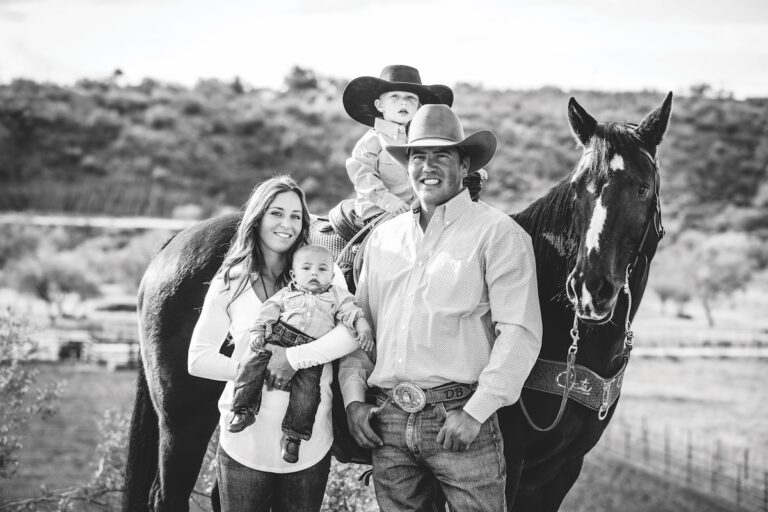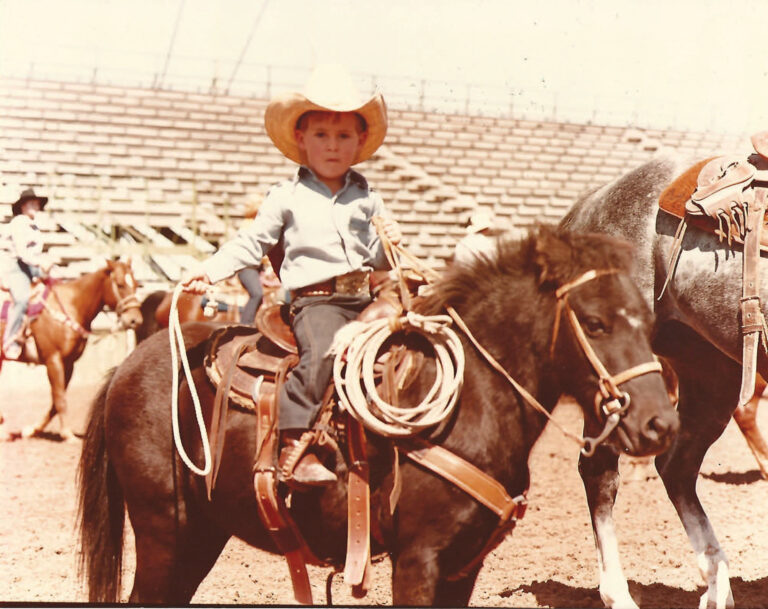Maybe you had plenty of game four decades ago. But today your sore joints, stiff tendons and weak muscles are trying to block you from the pay window. Maybe you’re hot stuff right now, but want to keep cashing checks in four decades. We spoke with some octogenarians and a veteran athletic trainer about what it takes to keep winning.
A couple of headers who’ve beaten Father Time pretty handily are Dick Yates, 85, who roped at 13 National Finals Rodeos, and Bill Spratt, 83, a rancher and former National Finals Steer Roping qualifier who winters amid the Arizona jackpots. Both said it’s not their mechanics that have been affected by the years. They still rope the same—they just don’t quite ride the same.
“The only thing I notice is sometimes me and my horse aren’t on the same page,” admitted Spratt, who sold 11-time NFR header Riley Minor his great horse Cadillac more than 15 years ago.
Digging up the core strength and reaction time to stay with his big, powerful head horses means Spratt needs a few more strides out of the box before he feels like he’s back at the front of his saddle.
“I suppose that’s the biggest thing I run into,” he said. “Once I get leveled off, it’s just like it’s always been. It just takes me longer to get together with my horse.”
Yates echoed that sentiment, saying an extra stride or two is necessary because he doesn’t get his arm up as quickly as he once did. Not only that, but he trains his horses to leave off his hand. If the reaction time of his hand isn’t perfect with his nod, sometimes his horse scores too good, so to speak.
“With the World Series start, it’s so easy to be late,” Yates said. “You’ve got to get going. It’s important to figure out the best way to score the horse you’re riding. Because they’re all different.”
Really knowing how to push that electric eye, based on your particular horse, is critical to compensating for slower reaction times. And swing speed is a biggie on either end of the steer.
“The main thing is to have that speed on your rope when you leave the box, so when you get to your target, you’re not trying to speed up your rope,” explained Yates, who’s had rotator cuff surgery on his right shoulder and an operation on his left after a horse fell with him. “And you need your arm and shoulder in it and not your wrist— that’s how to keep your loop open.”
[READ MORE: 5 Pearls of Team Roping Wisdom from Dick Yates]
Your horse’s stride also will affect your swing speed, and Yates said a long-strided horse is difficult for him to rope on, especially over short scores. Another thing he’s noticed as he’s gotten older is a tendency to ride too tight to the steer—which can make you wave it off and hurts your handle.
But still today, Yates’ positioning, timing and catch percentages are formidable. In Las Vegas at the Finale this year, the man caught every single steer except for one wave-off. While they didn’t pay him, he quipped that he’s “still working on their money.”
Strong and pain-free
Both Spratt and Yates credit their roping longevity with the fact that they’re constantly doing a little of it.
“They rope every day here,” Yates said of his facility in Pueblo, Colorado, where he practices with his Hall-of-Fame son, J.D. Yates, and NFR Average Champion grandson, Trey Yates. “I’ll rope three or four or five and that’s enough. I used to run 20 and not think anything about it. But I do a little bit of roping, pretty steady.”
That’s a good prescription, according to certified athletic trainer Rick Foster, who’s spent decades as a clinician for the Orthopaedic & Spine Center of the Rockies in Colorado. A mainstay of the Justin Sportsmedicine Team, now in its 43rd year supporting PRCA cowboys, Foster has also team roped sporadically since college and has himself had a dozen surgeries on shoulders, knees and ankles.
“The average age of timed-event horses at the NFR is 17 or 18 years old, which means there are plenty that are 20,” Foster said. “Consider how we take care of them. People are the same way as they get older.”
That means you want to warm up the muscles and tendons of a body that’s not so resilient anymore. If you warm up prior to using that right shoulder, you’ll feel better the next day. And he says how much you practice depends on several factors— your pain threshold, whether you’ve already rehabbed old injuries enough and what kind of shape you’re in.

“Overuse and repetitive injuries are no good,” Foster said. “The older you get, the less your body can handle repetition. That’s where tennis elbow and rotator cuff deterioration set in. Instead of throwing a hundred loops at a dummy, throw 25 quality loops. Because once you throw 25 quality loops. Because once you get flared up or get sore, it takes longer when you’re older to get that resolved. Quality over quantity is key.”
But consistency is also key. Spratt said one thing, in particular, has helped him the most.
“I ride practically every day,” he said. “I think as you get older, you have to ride every day. If I miss a week, I can tell a big difference. Plus, my horses need to be rode. And that’s good, it keeps me going. You can’t just sit in the house and then jump on a horse and win anything.”
Spratt likes the Powerline Lite ropes he’s used forever, and hasn’t felt any need to use anything different regardless of age. After all, he said with a grin, it ain’t the arrow. It’s the Indian.
Nutrition and movement
Spratt has five head horses right now, mostly out of Driftwood-bred mares with A Smooth Guy blood on top, being raised by his son T.J.’s family on the sprawling Spratt spread in the center of Wyoming.
“If my horse starts flat with his head low, I don’t need to hold the horn, but if he leaves hard and comes up a bit in front, then I need to pull myself back to the front of my saddle,” Spratt said. “I’ve got a few horses I don’t need the horn on, and I’ve got a couple that start really hard and throw me back.”
[READ MORE: Roping and Ranching with Bill Spratt]
Yates also holds his horn while leaving the corner. To keep your core strong and your coordination quick, Foster recommends regular movement or exercise away from Corrientes. Go for an easy jog if your knees and ankles can take it. Or go for a bike ride. Foster sees tons of pro cowboys carry bicycles on their rigs to ride around fairgrounds instead of driving.
“Pickleball has become a crazy trend and you can play on old beat-up knees and ankles,” Foster said. “Kaycee Feild put a pickleball court in his indoor arena!”
Not only that, but a recent study reported that people who play racket sports live longer. For something easy, Foster said a stationary bike is the best equipment you can have at home.
“You can sit there and read or scroll with your phone and look up and you’ve been riding 20 minutes already,” he said. “Plus, aerobic fitness helps maintain your hormone levels, which also helps with resilience, aiding metabolism and healing.”
Plus, Foster points out another benefit of exercise for strength and agility—good posture.
“Guys might say their swing doesn’t change as they get older, but their delivery changes because they’re not getting their elbow up as high and they’re not sitting up straight,” he explained.
Several pro athletes under Foster’s care use accessories like physio balls or foam rollers to help this, or they drive while leaning back into lacrosse balls to loosen trapezius and levator scapula muscles. If you visit JustinSportsmedicineTeam.com, you’ll find stretches and exercises along with videos of how to tape elbows, knees or wrists. PEMF therapy and cold lasers can alleviate inflammation, too. Foster emphasizes the importance of getting bloodwork done now and in later years.
“Metabolic challenges can really point to supplemental needs,” said Foster, who will accompany the Justin Sportsmedicine trailer to Greeley, Salinas and Cheyenne this month. “Older athletes need to pay more attention to nutrition in addition to exercise programs. It’s amazing how many people are deficient in vitamins, minerals and hormones.”
The two common deficiencies that, if supplemented, are great for healing and beating inflammation, he thinks, are Vitamin D and Omega 3.
“Omega 3 supplements are crucial to keep your brain and eyes healthy as you get older, and it’s a natural anti-inflammatory,” he said. “It’s perfect for all of us to be on. It’s not just fish oil. Look for the name to actually be ‘Omega 3.’”
Not only that, but Justin Sportsmedicine’s assistant medical director recommends taking curcumin or turmeric when you’re sore or injured. These supplements are great natural anti-inflammatories and should decrease the amount of painkillers you need to take.
Sheer will
Someone who should own stock in Aleve is one of the world’s longest-lasting and winningest jackpot heelers—Arizona’s Earl Higgins. The 85-year-old said besides regular cortisone shots in his right shoulder, he doesn’t do much to keep going. That’s despite the surgery on his left shoulder after a horse fell with him, and three back surgeries that made his feet feel like they’re floating in water.
“Walking is good for your back, but I can’t walk very far,” said Higgins, who banked $54,000 at the Finale in December and heeled his way to Arizona envelopes containing another $40,500 in cash just since January. “My worst problem is with my hands. I’ve got so much arthritis in my fingers, sometimes it’s difficult.”
[READ MORE: The Man, The Myth, The Legend: Earl Higgins]
When Higgins gets around in the morning, he rubs a good dose of Voltaren cream into those hands. But, like Spratt and Yates, he’s never stopped for very long.
“Ever since forever, I’ve roped my sawhorse,” Higgins said. “I’ve roped it in a wheelchair and I’ve roped it in a walker. It keeps your swing like it’s supposed to be.”
Like older headers, he thinks the hardest part of aging is losing your horsemanship— the corner gets harder to make. Higgins’ mare, Peanut Butter, is 20 and has been his main mount for three years. He typically waits to swing until he sees the head rope go on, although so many old roped-out cattle hug the right fence in the lower-numbered ropings.
“They flagged me out for crossfire recently,” Higgins said. “They’ll put me in the Guinness Book of World Records for the oldest guy ever flagged out for crossfire. I just had a shot, so I took it. But a lot of times, all I get to swing is twice. Because if a steer goes to the right fence, you can’t swing until he turns.”
These men limber up—and keep winning— by riding or swinging a rope just about every day. And Yates said this era is no different than his heyday 45 years ago: the better horsemen rise to the top regardless of age. Sure, everything might take you just a jump or two longer. But if you go do your job and don’t beat yourself, you’ll get a piece of the action, Yates said.
As for all those aches and pains along the way?
“You just have to ignore a bunch of it, because it’s not going away,” Higgins said. “It’s about the will to win.” TRJ











